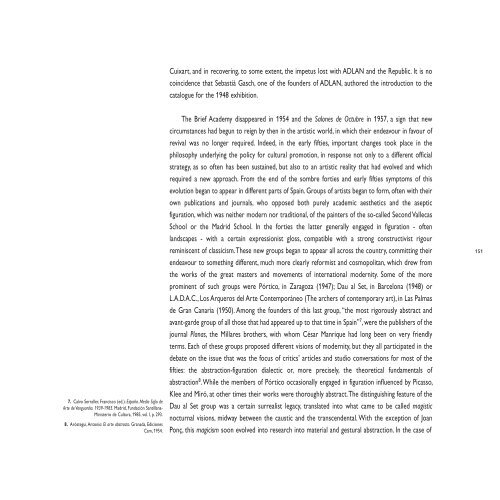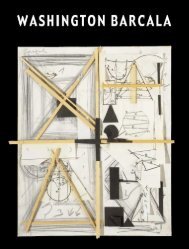VERSIÓN INGLESA ENGLISH VERSION - Fundación César Manrique
VERSIÓN INGLESA ENGLISH VERSION - Fundación César Manrique
VERSIÓN INGLESA ENGLISH VERSION - Fundación César Manrique
You also want an ePaper? Increase the reach of your titles
YUMPU automatically turns print PDFs into web optimized ePapers that Google loves.
7. Calvo Serraller, Francisco (ed.): España. Medio Siglo de<br />
Arte de Vanguardia. 1939-1985. Madrid, <strong>Fundación</strong> Santillana-<br />
Ministerio de Cultura, 1985, vol. I, p. 293.<br />
8. Aróstegui, Antonio: El arte abstracto. Granada, Ediciones<br />
Cam, 1954.<br />
Cuixart, and in recovering, to some extent, the impetus lost with ADLAN and the Republic. It is no<br />
coincidence that Sebastià Gasch, one of the founders of ADLAN, authored the introduction to the<br />
catalogue for the 1948 exhibition.<br />
The Brief Academy disappeared in 1954 and the Salones de Octubre in 1957, a sign that new<br />
circumstances had begun to reign by then in the artistic world, in which their endeavour in favour of<br />
revival was no longer required. Indeed, in the early fifties, important changes took place in the<br />
philosophy underlying the policy for cultural promotion, in response not only to a different official<br />
strategy, as so often has been sustained, but also to an artistic reality that had evolved and which<br />
required a new approach. From the end of the sombre forties and early fifties symptoms of this<br />
evolution began to appear in different parts of Spain. Groups of artists began to form, often with their<br />
own publications and journals, who opposed both purely academic aesthetics and the aseptic<br />
figuration, which was neither modern nor traditional, of the painters of the so-called Second Vallecas<br />
School or the Madrid School. In the forties the latter generally engaged in figuration - often<br />
landscapes - with a certain expressionist gloss, compatible with a strong constructivist rigour<br />
reminiscent of classicism. These new groups began to appear all across the country, committing their<br />
endeavour to something different, much more clearly reformist and cosmopolitan, which drew from<br />
the works of the great masters and movements of international modernity. Some of the more<br />
prominent of such groups were Pórtico, in Zaragoza (1947); Dau al Set, in Barcelona (1948) or<br />
L.A.D.A.C., Los Arqueros del Arte Contemporáneo (The archers of contemporary art), in Las Palmas<br />
de Gran Canaria (1950). Among the founders of this last group, “the most rigorously abstract and<br />
avant-garde group of all those that had appeared up to that time in Spain” 7 , were the publishers of the<br />
journal Planas, the Millares brothers, with whom <strong>César</strong> <strong>Manrique</strong> had long been on very friendly<br />
terms. Each of these groups proposed different visions of modernity, but they all participated in the<br />
debate on the issue that was the focus of critics’ articles and studio conversations for most of the<br />
fifties: the abstraction-figuration dialectic or, more precisely, the theoretical fundamentals of<br />
abstraction 8 . While the members of Pórtico occasionally engaged in figuration influenced by Picasso,<br />
Klee and Miró, at other times their works were thoroughly abstract. The distinguishing feature of the<br />
Dau al Set group was a certain surrealist legacy, translated into what came to be called magistic<br />
nocturnal visions, midway between the caustic and the transcendental. With the exception of Joan<br />
Ponç, this magicism soon evolved into research into material and gestural abstraction. In the case of<br />
151
















![Becas y premios de la Fundación César Manrique [1997-2006]](https://img.yumpu.com/20766851/1/184x260/becas-y-premios-de-la-fundacion-cesar-manrique-1997-2006.jpg?quality=85)
